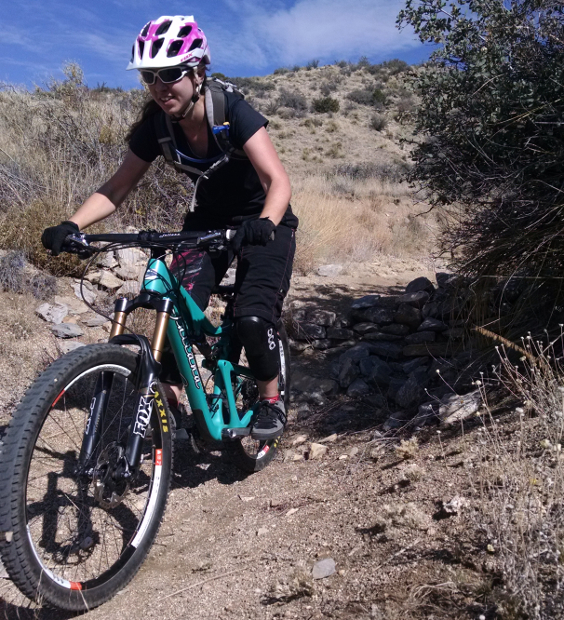Due primarily to an imbalance in numbers, women’s-specific mountain bikes are quite a niche market. As such, there are very few options for women that desire a women’s-specific mountain bike that is very aggressive and technically capable. Santa Cruz is one of the few brands that have taken a forward stance by supporting an entirely separate brand for women’s-specific mountain bikes: Juliana. While the Juliana line has been around for many years, Santa Cruz has recently revamped this line of bikes and has turned Juliana into a standalone brand. Though targeted specifically for women, the frames are admittedly standard Santa Cruz frames, with comparable or better components than the Santa Cruz equivalent, as well as a few feminine touches.

The Juliana Roubion is, in essence, the Santa Cruz Bronson. It boasts 6″ of travel and 27.5″ wheels. The “base” model comes built with a mix SRAM 1×11 and Shimano XT components, a RockShock Pike RCT3 fork, and Fox Float CTD Kashima shock, for a mere $6,599. The Roubion offers several customizations, such as an upgrade to the Cane Creek Double Barrel Air CS shock (highly recommended, especially for the price). The top offering boasts SRAM XX1 and Shimano XTR components for $8,299. Though the prices are somewhat high (ahem, quite high), make no mistakes that this is a top of the line bike, with a full-carbon frame for both of these build kits. When Santa Cruz and Juliana paired together to offer a demo day in Albuquerque, NM, I jumped at the opportunity to test ride the Roubion.
Though the demo bikes didn’t boast all of the standard options that come stock with the Roubion, such as the 1×11 system, I was able to take the Roubion out for a spin in the foothills of Albuquerque to get a feel for its capability.

Climbing
As a 6″ travel bike I fully anticipated it to bob as I climbed up steep, rocky ascents. However, this bike seemed almost as efficient as my 4″ and 5″ travel bikes that I ride on a regular basis, if not more efficient. Santa Cruz’s patented Virtual Pivot Point (VPP) suspension is the workhorse behind this capability. Their patented suspension design relies on two separate small linkages that create a “virtual” pivot point. In essence, the entire rear triangle is ultimately isolated from the rest of the bike, therefore providing higher pedaling efficiency without sacrificing suspension when you need it most on large drops.
I wanted to give the VPP a run for its money, so for half of the ride I set the fork and shock settings to the fully open, or the “descend” mode. The pedaling efficiency was only minimally hampered, and I honestly forgot during most of the climbs that the suspension was in descend mode. For the second half of the ride, which still offered a fair amount of technical climbing, I switched both fork and shock to the “climb” mode. There was minimal difference between the two settings, except for out of the saddle climbing. With 27.5″ wheels and great geometry, tight switchbacks were easy to maneuver.
Descending
With the nose of the bike pointed down, it was hard to wipe the smile off of my face. Small to medium jumps felt like spreading butter on warm toast. Honestly, while descending the only word that really came to mind was “supple.” Though not typically a word used to describe a mountain bike, the geometry, coupled with the suspension on this bike, results in extremely supple landings.
The geometry of the bike felt agressive, but stable. I felt much more confident and relaxed on technical sections with this bike then I have ever felt–quite the compliment for the Roubion given the number of times I have ridden the same trails with many other bikes. This held true regardless of the settings on the fork and shock, as I tackled rocky descents with both the “climb” and “descend” settings. This result speaks to the design of the geometry and suspension of the bike and not just a function of good components. The bike was nimble in corners, allowing me to take turns at much faster speeds than I typically do.
While I only had a couple of hours to test this bike, the Juliana Roubion left me salivating for more time to ride. Juliana has implemented some changes to the Roubion build kit in order to give the Bronson bones a more feminine touch, such as a gorgeous evergreen paint job and an extremely comfortable women’s-specific saddle. In addition, the bars measure in at a comfortable width of 720mm, the same as I run on my personal bike, with thinner grips to accommodate the smaller hands of women.
Though in essence Santa Cruz has founded a new line of women’s specific mountain bikes by merely implementing a “shrink and pink” brand, it’s a step in the right direction. Initially, I was quite perturbed by the mere thought that a bike company could appease the masses of women with a pretty paint job. While the number of women mountain biking may lag behind the men, it’s quite clear that there are enough women in the sport for money to be made. It won’t be long before the design and engineering goes beyond pretty paint schemes and fancy saddles. In the mean time, the Juliana Roubion is more than capable of allowing any woman the ability to show the boys how trails are supposed to be ridden, all while looking good.





















